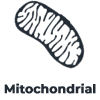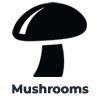Due to the fact that tiger milk mushroom has an effect on NGF, it has naturally been compared quite extensively with the most famous NGF modulating mushroom, lion’s mane! As we discovered earlier, tiger milk mushroom appears to mimic NGF, directly activating the TrkA receptor which NGF acts on. Due to this, it has a more direct and targeted effect in regards to NGF mediated effects, when compared to lion’s mane. Lion’s mane approaches NGF in a much different way. The active compounds present in the lion’s mane mycelium, for example erinacine A, stimulate the synthesis of NGF. The active compounds present in the fruiting bodies, for example hericenone E, appear to potentiate the effects of NGF, and other unknown compounds present in the fruiting bodies also appear to stimulate NGF synthesis. With this in mind, it is clear to see why tiger milk mushroom and lion’s mane are being compared!
Lion’s mane has much more research on it, so we have a better understanding of what it is doing cognitively, when compared to tiger milk mushroom. Due to this, we know of many more targets on which lion’s mane acts, for example it can also enhance brain derived neurotrophic factor (BDNF) and monoamine levels. Lion’s mane also appears to activate kappa-opioid receptors, specifically via the compound erinacine E. Lion’s mane may also mildly inhibits the 5-alpha reductase enzyme which converts testosterone into dihydrotestosterone (DHT). Taken together, this would indicate that lion’s mane has a much more full-spectrum effect than tiger milk mushroom. However, do keep in mind that due to the fact that the research into tiger milk mushroom and cognitive function is still very much lacking, we may learn a lot more about it in the coming years. For now, we mostly have to rely on anecdotal reports when comparing tiger milk mushroom to lion’s mane mushroom.
Anecdotally, we have found that tiger milk mushroom produces a zippier and cleaner effect than lion’s mane. It seems to be a little bit better at dialing in focus, while it loses out to lion’s mane in terms of enhancing mood and mental clarity. Similar types of anecdotal reports have also started to pop up on reddit. It seems that the effects of tiger milk mushroom are a little bit more acute, and are especially beneficial for those looking to gain a quick mental edge. In terms of the long term effects, tiger milk mushroom and lion’s mane mushroom start to converge after some time. Both seem to be excellent at dialing in memory over time, which makes sense since they are both producing a large portion of their memory effects via NGF related pathways.
Tiger milk mushroom also stands out from lion’s mane mushroom for its respiratory function promoting effects. These effects are quite unique to tiger milk mushroom and we did not notice similar respiratory function benefits with lion’s mane. That being said, both should have fairly equal effects on overall immune function.
Anecdotally we have also seen reports that individuals who did not respond well to lion’s mane mushroom, do end up responding well to tiger milk mushroom. This likely has something to do with tiger milk mushroom’s overall “cleaner” effects profile. Thus, if you have previously not responded well to lion’s mane mushroom, but would like to experience similar benefits, then tiger milk mushroom could be a great choice! We’d also be remiss to not mention that for those who do respond well to lion’s mane mushroom, a combination of tiger milk mushroom and lion’s mane mushroom seems to be an incredible combination. In fact, tiger milk mushroom really seems to lend itself to stacking, so let’s dive into that topic next!









